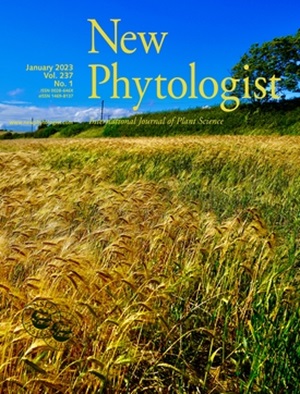The PHYTOCHROME INTERACTING FACTOR 3, a bHLH transcription factor, promotes thermosensory growth by directly activating PIF4 transcription and its protein accumulation in Arabidopsis
IF 8.1
1区 生物学
Q1 PLANT SCIENCES
引用次数: 0
Abstract
- The role of PHYTOCHROME INTERACTING FACTOR 3 (PIF3) in thermomorphogenesis, despite being a crucial regulator of photosensory hypocotyl growth in Arabidopsis, remains unknown.
- Here, we demonstrate PIF3 as a key and novel component of the thermosensory pathway. pif3 mutants show reduced sensitivity to warm temperature-induced hypocotyl elongation, which is more pronounced at higher light intensities. pif3 mutant exhibits moderate impairment in petiole elongation and flowering. By contrast, PIF3 overexpression lines show constitutive thermomorphogenic responses.
- Whole-genome transcriptome analysis revealed that genes induced by warm temperature are significantly downregulated in the pif3 mutant but are constitutively upregulated in the PIF3 overexpression line. Moreover, PIF3 directly activates PIF4 transcription by binding to the PIF-binding element (PBE-box) in a temperature-dependent manner.
- Chromatin immunoprecipitation (ChIP) and biochemical data indicate that PIF4 binding to its target genes requires PIF3. The physical interaction between PIF3 and PIF4 is likely required for the optimal expression of downstream genes involved in metabolism and growth. Epistatic and gene regulation analysis further revealed that PIF3 functions in PIF4-dependent and PIF4-independent pathways to regulate gene expression. This study unravels the novel role, and mechanism through which, PIF3 promotes thermomorphogenic growth in Arabidopsis.
光敏色素相互作用因子3是一种bHLH转录因子,通过直接激活PIF4转录及其蛋白积累来促进拟南芥的热感觉生长。
光敏色素相互作用因子3 (PIF3)在拟南芥热形态发生中的作用,尽管是光感觉下胚轴生长的关键调节因子,但仍不清楚。在这里,我们证明了PIF3是热感觉通路的一个关键和新的组成部分。Pif3突变体对温暖温度诱导的下胚轴伸长的敏感性降低,这在较高的光照强度下更为明显。Pif3突变体在叶柄伸长和开花方面表现出中度损伤。相比之下,PIF3过表达系表现出本构性热形态反应。全基因组转录组分析显示,温暖温度诱导的基因在pif3突变体中显著下调,但在pif3过表达系中组成性上调。此外,PIF3通过以温度依赖的方式与pif结合元件(PBE-box)结合,直接激活PIF4的转录。染色质免疫沉淀(ChIP)和生化数据表明,PIF4与靶基因的结合需要PIF3。PIF3和PIF4之间的物理相互作用可能是参与代谢和生长的下游基因最佳表达所必需的。上位性和基因调控分析进一步揭示了PIF3在pif4依赖性和pif4非依赖性通路中调控基因表达。本研究揭示了PIF3在拟南芥中促进热形态生长的新作用和机制。
本文章由计算机程序翻译,如有差异,请以英文原文为准。
求助全文
约1分钟内获得全文
求助全文
来源期刊

New Phytologist
生物-植物科学
自引率
5.30%
发文量
728
期刊介绍:
New Phytologist is an international electronic journal published 24 times a year. It is owned by the New Phytologist Foundation, a non-profit-making charitable organization dedicated to promoting plant science. The journal publishes excellent, novel, rigorous, and timely research and scholarship in plant science and its applications. The articles cover topics in five sections: Physiology & Development, Environment, Interaction, Evolution, and Transformative Plant Biotechnology. These sections encompass intracellular processes, global environmental change, and encourage cross-disciplinary approaches. The journal recognizes the use of techniques from molecular and cell biology, functional genomics, modeling, and system-based approaches in plant science. Abstracting and Indexing Information for New Phytologist includes Academic Search, AgBiotech News & Information, Agroforestry Abstracts, Biochemistry & Biophysics Citation Index, Botanical Pesticides, CAB Abstracts®, Environment Index, Global Health, and Plant Breeding Abstracts, and others.
 求助内容:
求助内容: 应助结果提醒方式:
应助结果提醒方式:


